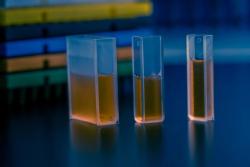
OR WAIT null SECS
- About Us
- Advertise
- Contact Us
- Editorial Info
- Editorial Advisory Board
- Do Not Sell My Personal Information
- Privacy Policy
- Terms and Conditions
© 2025 MJH Life Sciences™ , Pharmaceutical Technology - Pharma News and Development Insights. All rights reserved.
Evaluating the Tech Transfer Process
Unforeseen challenges can be avoided in technology transfer by evaluating the variety of processes involved.
Technology transfer is a multifaceted task that involves different departments and expertise within a pharmaceutical organization. It is a task, therefore, that can come with unforeseen challenges, even when the process may seem simple, according to Joerg Zimmermann, vice-president Vetter Development Service at Vetter Pharma-Fertigung GmbH & Co. KG. Pharmaceutical Technology spoke with Zimmermann about the tech transfer process and how companies can make this transfer as painless as possible.
Beginning the tech transfer process
PharmTech: What are the first steps that should be taken when starting the process of transferring information and processes from one group or company to another?
Zimmermann (Vetter): I think the most important thing is to perform a combination of a gap and risk analysis between the existing process at the sending site and the envisioned process at the receiving site. This practice assists in identifying and evaluating the manufacturing and testing steps along with organizational issues and logistics, and it assesses the risk of identified differences between the transfer sites. In the spirit of International Council for Harmonization (ICH) Q8(R2) Pharmaceutical Development, the results of a thorough evaluation of the quality target product profile (QTPP) of the product and the associated critical quality attributes (CQAs) define the scope of the transfer.
PharmTech: Should both entities be involved in developing the tech transfer process?
Zimmermann (Vetter): Certainly, as open communication and trust is key. The closer the sending and receiving sites work together, the better the transfer will work out. The sending site will usually have years of practical experience and defined routines, while the transfer itself offers the opportunity to redesign and modernize elements of the process. Wherever possible, you should involve the people that are actually making and testing the product since a good deal of know-how is not actually in the documents themselves, but in the heads of the people involved!
PharmTech: How does tech transfer differ between in-company transfers and sponsor/contract facility transfers? Are the process steps different?
Zimmermann (Vetter): In general, there is no difference either in the process itself or in the regulatory aspects. However, there may be underlying resistance from the sending site in the case of a sponsor. This is something that must be dealt with within the ‘cultural’ part of the project. Procedurally, there will always be differences in the ways of working, including the quality systems. As such, these too must be evaluated.
Evaluating processes during tech transfer
PharmTech: Which manufacturing processes should be evaluated when it comes to tech transfer?
Zimmermann (Vetter): All processes should be evaluated from start to finish including all unit operations. For aseptic fill/finish operations, processes would include compounding, sterile filtration, filling, visual inspection, and secondary packaging.
PharmTech: Which analytical processes should be evaluated in tech transfer?
Zimmermann (Vetter): There will always be several analytical processes that need to be transferred, for example, in-process testing as well as release testing. The extent of the transfer itself depends on the analytical capabilities of the receiving site. It is possible to establish and run all analytical procedures, be they chemical, biological, microbiological, or physical tests for in-process testing, product release testing, and stability testing. The test can be something simple like pH, or more complex like an SDS–PAGE [sodium dodecyl sulfate polyacrylamide gel electrophoresis] for proteins.
PharmTech: Which quality and/or validation process should be evaluated in tech transfer?
Zimmermann (Vetter): The inception of any process transfer is the process qualification campaign, which is based on FDA’s approach of first (process design), second (process qualification), and third (continuous process verification). Its purpose is always to achieve a robust, reproducible manufacturing process with consistent quality at the receiving site.
Operations in tech transfer
PharmTech: Which team members/departments should be included in the tech transfer process?
Zimmermann (Vetter): Process transfers are usually run as projects with dedicated cross-departmental teams. These include development, manufacturing operations, quality assurance and quality control, qualification/validation, and regulatory affairs. It also includes production planning and logistics. All are organized and coordinated by a project manager who reports to the project sponsor. Ideally, all functions from both sites are involved to a certain extent with respective partners in the other organization. In this way, subject matter experts can directly communicate with their peers.
PharmTech: How can tech transfer operations affect current/other manufacturing operations both at the sponsor site and the outsourcing site?
Zimmermann (Vetter): It is the nature of the business that to a certain extent, the introduction of new products and processes will interrupt running operations. Thus, the goal is to always keep interruptions to a minimum. The receiving site should always have a vested interest in both a smooth transfer and a robust process as they will be running it for years, or even decades into the future.
PharmTech: Are there specific tools used in tech transfer? If yes, what, where, and why?
Zimmermann (Vetter): Most certainly. Strong project management is paramount in any tech transfer. The roles and responsibilities for all team members must be agreed upon and a system that enables adequate communication and feedback of information must be established. All pharmaceutical process steps can be directly derived following ICH Q8(R2) (1) and FDA guidance (2). Based on prior knowledge of similar products and processes, a smooth and swift process transfer can be designed and executed.
References
1. ICH, Q8 (R2) Pharmaceutical Development (ICH, August 2009).
2. FDA, Guidance for Industry, Process Validation: General Principles and Practices (CDER, CBER, CVM, January 2011).
Article Details
Pharmaceutical Technology
Vol. 43, No. 11
November 2019
Pages: 53-54
Citation
When referring to this article, please cite it as S. Haigney, "Evaluating the Tech Transfer Process," Pharmaceutical Technology 43 (11) 2019.

 Download Issue: Pharmaceutical Technology-11-02-2019
Download Issue: Pharmaceutical Technology-11-02-2019

